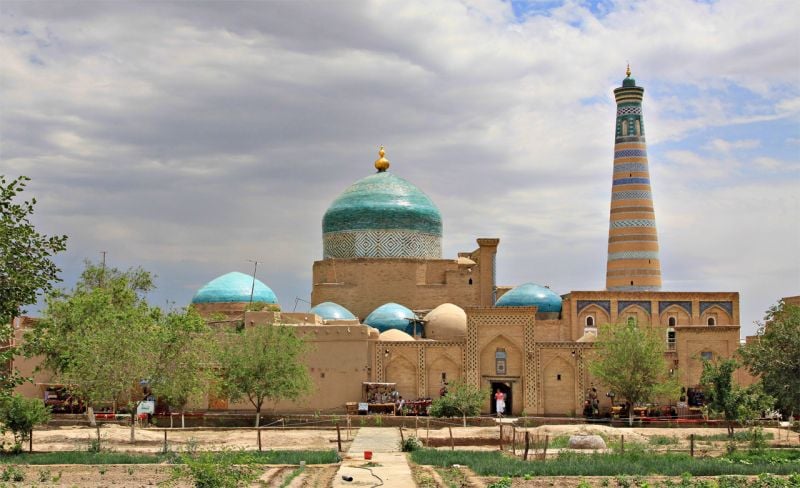Discover 12 hidden attractions, cool sights, and unusual things to do in Uzbekistan. Don't miss out on these must-see attractions: Gur Emir Mausoleum (Samarkand), Registan (Samarkand) or Bibi-Khanym Mosque (Samarkand).
Below, you can find the list of the most amazing places you should visit in Uzbekistan.
Table of Contents
Gur Emir Mausoleum, Samarkand
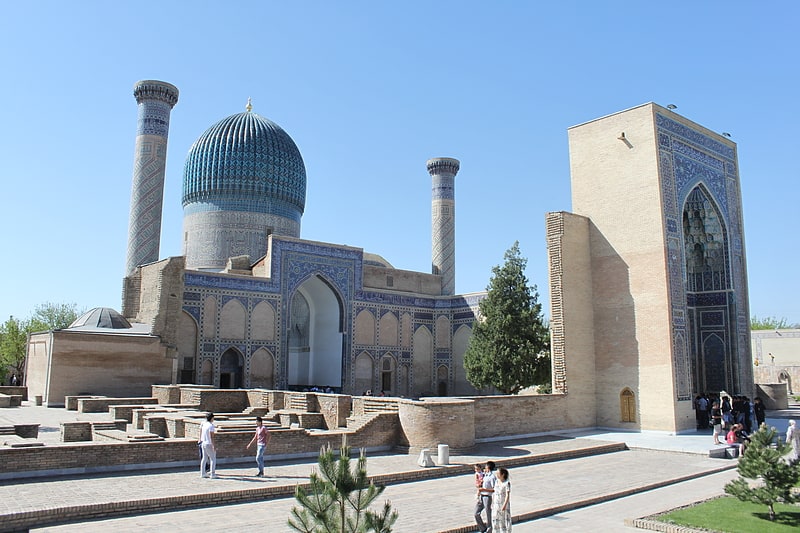
Also known as: Amir Temur maqbarasi
Early-1400s mausoleum with mosaics. The Gūr-i Amīr or Guri Amir is a mausoleum of the Turco-Mongol conqueror Timur in Samarkand, Uzbekistan. It occupies an important place in the history of Central Asian Architecture as the precursor for and had influence on later Great Mughal architecture tombs, including Gardens of Babur in Kabul, Humayun's Tomb in Delhi and the Taj Mahal in Agra, built by Timur's Indian descendants, Turco-Mongols that followed Indian culture with Central Asian influences, and who successively married into the Hindu Rajput dynasties of the Indian subcontinent and became Indianised over time. Mughals established the ruling Mughal dynasty of the Indian subcontinent. The mausoleum has been heavily restored.[1]
Address: 1/4, Universitetskiy Boulevard Бўстонсарой кўчаси, Samarkand
Registan, Samarkand
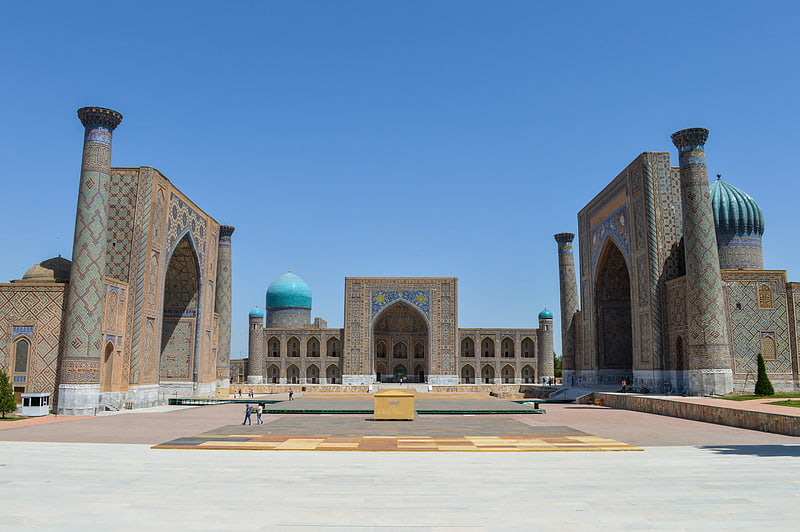
Also known as: Registon ansambli
Public square with historic madrasas. The Registan was the heart of the ancient city of Samarkand of the Timurid Empire, now in Uzbekistan. The name Rēgistan means "sandy place" or "desert" in Persian.
The Registan was a public square, where people gathered to hear royal proclamations, heralded by blasts on enormous copper pipes called dzharchis - and a place of public executions. It is framed by three madrasahs (Islamic schools) of distinctive Islamic architecture. The square was regarded as the hub of the Timurid Renaissance.[2]
Bibi-Khanym Mosque, Samarkand
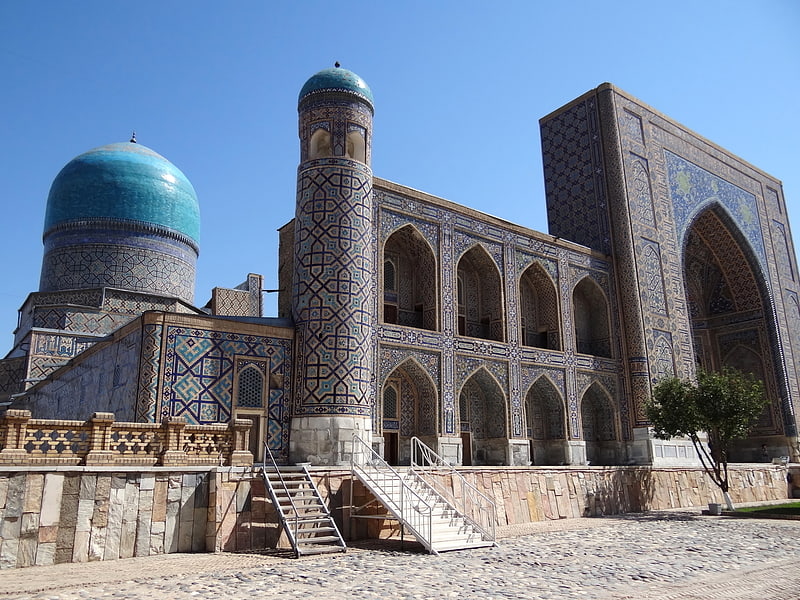
Also known as: Bibi-Xonim masjidi
Monument in Samarkand, Uzbekistan. The Bibi-Khanym Mosque is one of the most important monuments of Samarkand, Uzbekistan. In the 15th century, it was one of the largest and most magnificent mosques in the Islamic world. It is considered a masterpiece of the Timurid Renaissance. By the mid-20th century, only a grandiose ruin of it still survived, but major parts of the mosque were restored during the Soviet period.[3]
Address: Bibikhonim Str., Samarkand
Itchan Kala, Khiva
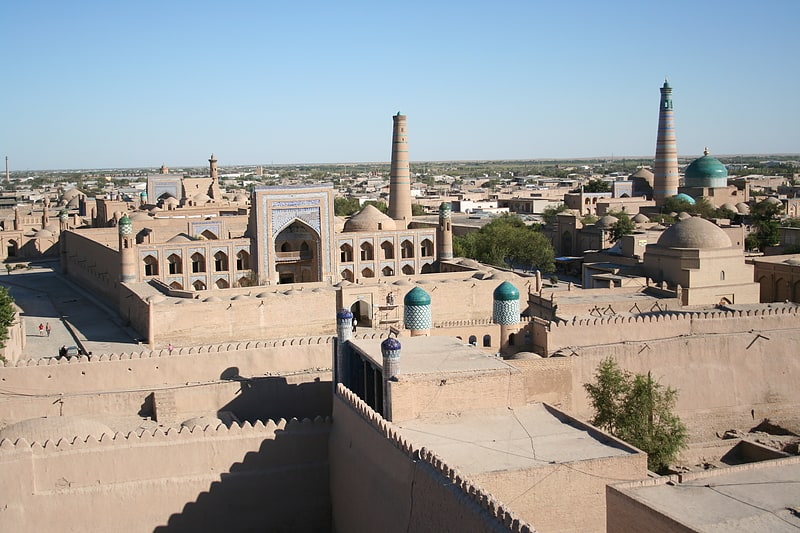
Also known as: Ichan qalʼa
Walled inner town of the city of Khiva. Itchan Kala is the walled inner town of the city of Khiva, Uzbekistan. Since 1990, it has been protected as a World Heritage Site.
The old town retains more than 50 historic monuments and 250 old houses, dating primarily from the eighteenth or nineteenth centuries. Juma Mosque, for instance, was established in the tenth century and rebuilt from 1788 to 1789, although its celebrated hypostyle hall still retains 112 columns taken from ancient structures.
The most spectacular features of Itchan Kala are its crenellated brick walls and four gates, one at each side of the rectangular fortress. Although the foundations are believed to have been laid in the tenth century, present-day 10-metre-high (33 ft) walls were erected mostly in the late seventeenth century and later repaired.
Notable buildings in Itchan Kala are Juma Mosque, Ak Mosque, madrasahs of Alla-Kulli-Khan, Muhammad Aminkhon, Muhammad Rakhimkhon, Mausoleums of Pahlavon Mahmoud, Sayid Allavuddin, Shergozikhon as well as caravanserais and markets.[4]
Kalyan Minaret, Bukhara

Also known as: Minorai kalon
Historical landmark in Bukhara, Uzbekistan. The Kalyan Minaret is a minaret of the Po-i-Kalyan mosque complex in Bukhara, Uzbekistan and one of the most prominent landmarks in the city.
The minaret, designed by Bako, was built on an earlier existing structure called Kalyan by the Qarakhanid ruler Mohammad Arslan Khan in 1127 to summon Muslims to prayer five times a day. An earlier tower was collapsed before starting this structure which was called Kalyan, meaning welfare, indicating a Buddhist or zoroasterian past. It is made in the form of a circular-pillar baked brick tower, narrowing upwards. It is 45.6 metres (149.61 ft) high (48 metres including the point), of 9 metres (29.53 ft) diameter at the bottom and 6 metres (19.69 ft) overhead.
There is a brick spiral staircase that twists up inside around the pillar to the rotunda. The tower base has narrow ornamental strings belted across it made of bricks which are placed in both straight or diagonal fashion. The frieze is covered with a blue glaze with inscriptions.
In times of war, warriors used the minaret as a watchtower to lookout for enemies.
About a hundred years after its construction, the tower so impressed Genghis Khan that he ordered it to be spared when all around was destroyed by his men. It is also known as the Tower of Death, because until as recently as the early twentieth century criminals were executed by being thrown from the top. Fitzroy Maclean, who made a surreptitious visit to the city in 1938, says in his memoir Eastern Approaches, "For centuries before 1870, and again in the troubled years between 1917 and 1920, men were cast down to their death from the delicately ornamented gallery which crowns it."[5]
Address: Khodja Nurobobod Street, 200100 Bukhara
Samanid Mausoleum, Bukhara

Also known as: Ismoil Somoniy maqbarasi
Iconic shrine with intricate brickwork. The Samanid Mausoleum is a mausoleum located in the northwestern part of Bukhara, Uzbekistan, just outside its historic center. It was built in the 10th century CE as the resting place of the powerful and influential Islamic Samanid dynasty that ruled the Samanid Empire from approximately 900 to 1000. It contained three burials, one of whom is known to have been that of Nasr II.
The mausoleum is considered one of the iconic examples of early Islamic architecture and is known as the oldest funerary building of Central Asian architecture. The Samanids established their de facto independence from the Abbasid Caliphate in Baghdad and ruled over parts of modern Afghanistan, Iran, Uzbekistan, Tajikistan, and Kazakhstan. It is the only surviving monument from the Samanid era, but American art historian Arthur Upham Pope called it the "one of the finest in Persia".
Perfectly symmetrical, compact in its size, yet monumental in its structure, the mausoleum not only combined multi-cultural building and decorative traditions, such as Sogdian, Sassanian, Persian and even classical and Byzantine architecture, but incorporated features customary for Islamic architecture – a circular dome and mini domes, pointed arches, elaborate portals, columns and intricate geometric designs in the brickwork. At each corner, the mausoleum's builders employed squinches, an architectural solution to the problem of supporting the circular-plan dome on a square. The building was buried in silt some centuries after its construction and was revealed during the 20th century by archaeological excavation conducted under the USSR.[6]
Address: M. Ashrafi Street, Bukhara
Po-i-Kalyan, Bukhara

Mosque in Bukhara, Uzbekistan. Po-i-Kalan, or Poi Kalan, is an Islamic religious complex located in Bukhara, Uzbekistan. The complex consists of three parts, the Kalan Mosque, the Kalan Minaret to which the name refers to, and the Mir-i-Arab Madrasah. The positioning of the three structures creates a square courtyard in its center, with the Mir-i-Arab and the Kalan Mosque standing on opposite ends. In addition, the square is enclosed by a bazaar and a set of baths connected to the Minaret on the northern and southern ends respectively.
The congregational mosque in the complex is one of the largest mosques in Central Asia, behind the Bibi Khanum Mosque in Samarkand, Uzbekistan, and the Great Mosque of Herat in Afghanistan.[7]
Chorsu Bazaar, Tashkent

Historical market square in Tashkent, Uzbekistan. Chorsu Bazaar, also called charsu bazaar, is the traditional bazaar located in the center of the old town of Tashkent, the capital city of Uzbekistan. Under its blue-colored domed building and the adjacent areas, all daily necessities are sold.[8]
Address: Navoi St. 48, Tashkent
Museum of Arts of Uzbekistan, Tashkent
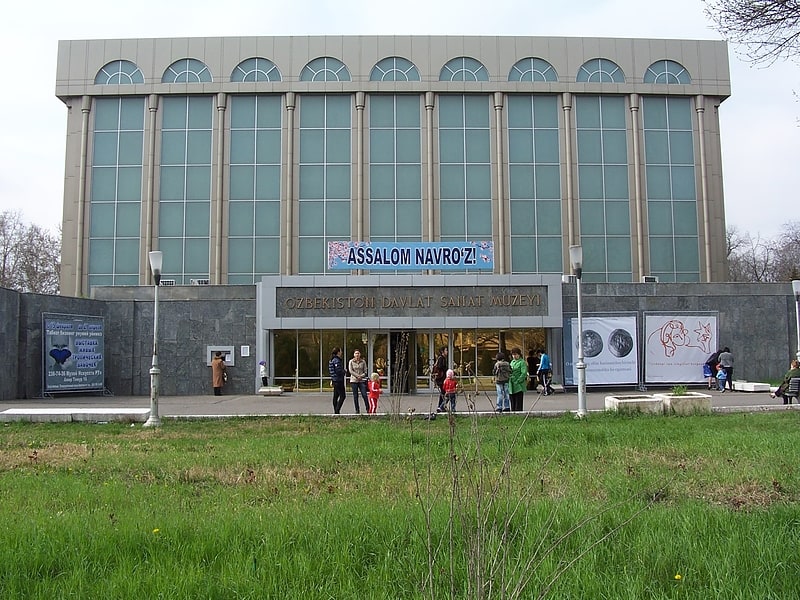
Also known as: Oʻzbekiston Davlat Sanʼat muzeyi
Museum in Tashkent, Uzbekistan. The Museum of Arts of Uzbekistan is the largest state art museum in Uzbekistan. Its permanent collection contains more than several thousands works, divided among four curatorial departments. The museum was established in 1918 as a Museum of People University and renamed as a Central Arts Museum later. It was named as Tashkent Art Museum in 1924 and finally Museum of Arts of Uzbekistan in 1935.[9]
Amir Timur Museum, Tashkent
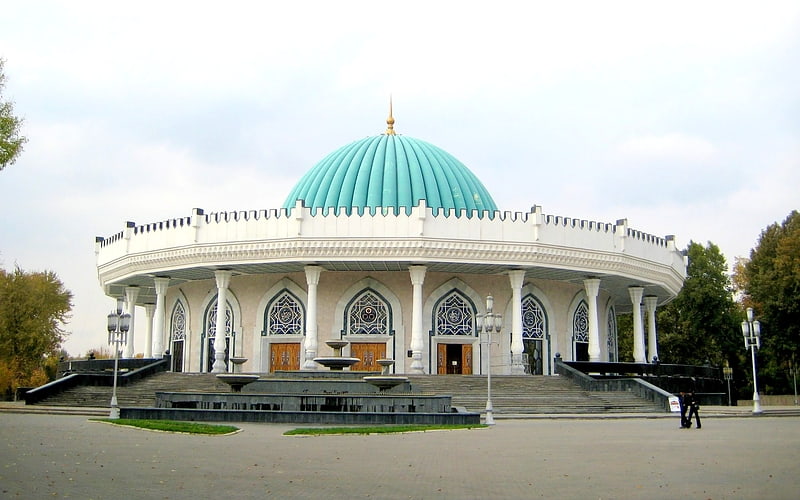
Also known as: Temuriylar tarixi davlat muzeyi
Museum in Tashkent, Uzbekistan. The Amir Timur Museum is located in Tashkent, the capital of Uzbekistan. It opened in 1996, and is dedicated to the Turco-Mongol warlord Amir Timur.[10]
Address: 13 Амир Темур шоҳ кўчаси, 100000 Тошкент
Kalta Minor, Khiva
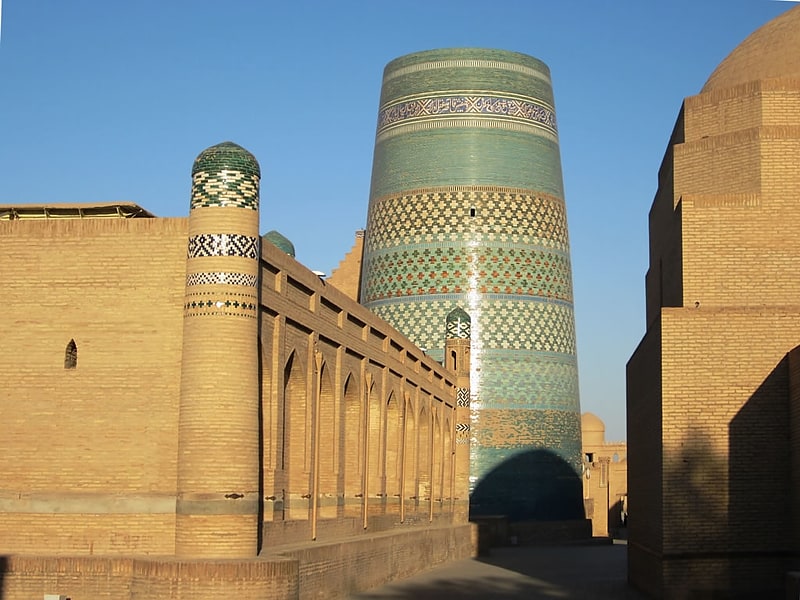
Tower
Pahlavon Mahmud Mausoleum, Khiva
